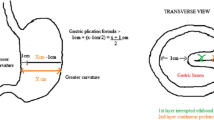Abstract
Background
Bariatric surgery in superobese (BMI > 50 kg/m2) and super-superobese (BMI > 60 kg/m2) patients can be a formidable technical and therapeutic challenge because these patients often present multiple medical, surgical, and anesthetic risks. Only a few dedicated reports on different surgical options in this kind of patient population are available. The aim of this study is the evaluation of laparoscopic adjustable gastric banding (LAGB) results in an unselected populations of super-superobese patients operated during the last 4 years.
Methods
Super-superobese (BMI > 60 kg/m2) patients who underwent LAGB were recruited from the prospective database of our institution. LapBand® System (Allergan, Irvine, CA, USA) was positioned in all cases via pars flaccida, 1–2 cm below the gastroesophageal junction and fixed anteriorly with three non-absorbable stitches. The band was not filled at the time of surgery. Operative time, co-morbidities, laparotomic conversion, intra- and postoperative complications, mortality, and weight-loss-related parameters were considered. Data were expressed as mean ± standard deviation, except as otherwise indicated.
Results
From January 2003 to December 2006, 823 patients underwent a bariatric surgical procedure, 95 of whom (11.5%) were BMI > 60 kg/m2 (59 F/ 36 M; mean BMI, 62.5 ± 4.2; range, 60.1–77 kg/m2; mean age 38.5 ± 13.5, range 18–61 years old). Mortality, intraoperative, and 30-day major complications were absent. One or more preoperative co-morbidities were diagnosed in 90 of 95 (94.7%) patients. After 1 year, co-morbidity-free patients increased from five of 95 (5.3%) to 27 of 95 (28%; p < 0.001). Patients with three or more co-morbidities decreased from 62 of 95 (65.3%) to 0 (p < 0.001). Mean BMI was 43.6 in 95 of 95, 37.9 in 55 of 55, 29.1 in 11 of 11, and 28.9 in five of five patients at 12, 24, 36, and 48 months, respectively. At the same time, %EWL was 53.6, 69.7, 81.3, and 82.1 and %EBL was 50, 66, 90, and 91.
Conclusions
LAGB can be considered an appropriate bariatric surgical option in super-superobese patients both for low morbidity rate and weight loss. The end-point of BMI < 30 can be achieved with a multidisciplinary follow-up. Additional studies with more patients and longer follow-up are needed to confirm these observations.


Similar content being viewed by others
References
Fielding GA. Laparoscopic adjustable gastric banding for massive superobesity (>60 body mass index kg/m2). Surg Endosc. 2003;17:1541–5.
Capella JF, Capella RF. The weight reduction operation of choice: vertical banded gastroplasty or gastric bypass. Am J Surg. 1969;171:74–9.
Brolin R, LaMarca L, Kenler H, et al. Malapsorptive gastric bypass in patients with superobesity. J Gastrointestinal Surg. 2002;6:195–205.
Sarr MC, Felty CC, Hilmer DM, et al. Technical and practical considerations involved in operations on patients weighing more than 270 Kg. Arch Surg. 1995;1309:102–5.
Marceau P, Hold PS, Simmond S, et al. Biliopancreatic diversion with duodenal switch. World J Surg. 1998;122:947–54.
Angrisani L, Furbetta F, Doldi SB, et al. Results of the Italian multicentric study on 239 superobese patients treated by adjustable gastric banding. Obes Surg. 2002;12:846–50.
Myers JA, Sarker S, Shayani V. Treatment of massive superobesity with laparoscopic adjustable gastric banding. SOARD 2006;2:37–40.
Fazylov RM, Savel RH, Horovitz JH, et al. Association of super-super-obesity and male gender with elevated mortality in patients undergoing the duodenal switch procedure. Obes Surg. 2005;15:618–23.
Regan JP, Inabnet WB, Gagner M, et al. Early experience with two stage laparoscopic roux-en-Y gastric bypass as an alternative in the Super-superobese patient. Obes Surg. 2003;13:861–4.
Mongol P, Chosidow D, Marmuse JP. Laparoscopic gastric bypass versus laparoscopic adjustable gastric banding in the superobese: a comparative study of 290 patients. Obes Surg. 2005;15:76–81.
Artuso D, Wayne M, Kaul A, et al. Extremely high body mass index is not a contraindication to laparoscopic gastric bypass. Obes Surg. 2004;14:750–4.
Farkas DT, Vemulapalli P, Haider A, et al. Laparoscopic Roux-en-Y gastric bypass is safe and effective in patients with a BMI > 60. Obes Surg. 2005;15:486–93.
Helling TS. Operative experience and follow up in a cohort of patients with a BMI >70 Kg/m2. Obes Surg. 2005;15:482–95.
Parikh MS, Shen R, Weiner M, et al. Laparoscopic bariatric surgery in superobese patients (BMI > 50) is safe and effective: a review of 332 patients. Obes Surg. 2005;15:858–63.
Dolan K, Hatzifotis M, Newbury L, et al. A comparison of laparoscopic adjustable gastric banding and iliopancreatic diversion in superobesity. Obes Surg. 2004;14:165–9.
Murr MM, Balsiger BM, Kennedy FP, et al. Malabsorptive procedures for severe obesity: comparison of pancreaticobiliary bypass and very, very long limb Roux-n-Y gastric bypass. J Gastrointest Surg. 1999;3:607–12.
Oliak D, Ballantyne GH, Davies RJ, et al. Short-term results of laparoscopic gastric bypass in patients with BMI > or = 60. Obes Surg. 2002;12:643–7.
Acknowledgment
Here’s to Antonio J Cascardo, wonderful surgeon, great friend.
Author information
Authors and Affiliations
Corresponding author
Rights and permissions
About this article
Cite this article
Torchia, F., Mancuso, V., Civitelli, S. et al. LapBand System® in Super-Superobese Patients (>60 kg/m2): 4-Year Results. OBES SURG 19, 1211–1215 (2009). https://doi.org/10.1007/s11695-008-9760-z
Received:
Accepted:
Published:
Issue Date:
DOI: https://doi.org/10.1007/s11695-008-9760-z




